Amidst Nevada’s diverse landscapes, from its vast deserts to its alpine forests and extensive mountain ranges, a captivating array of owls find their home. These nocturnal hunters play an integral role within the state’s ecosystems, operating as vital predators and important links in their food chains.
Nevada’s Owls
| Owl Species | Frequency in Nevada | Presence in Nevada | Specific Locations in Nevada |
|---|---|---|---|
| Long-eared Owl | Uncommon | Year-round | Dense stands of trees near open areas |
| Short-eared Owl | Uncommon | Winter | Wetlands, marshes |
| Western Screech-owl | Common | Year-round | Woodlands, often near water |
| Great Horned Owl | Common | Year-round | Throughout the state |
| Burrowing Owl | Uncommon | Breeding season | Desert grasslands with burrows |
| Barn Owl | Uncommon | Year-round | Farmland, open grasslands |
| Northern Pygmy Owl | Uncommon | Year-round | Mountainous forests |
| Northern Saw-whet Owl | Uncommon | Winter | Wooded areas |
| Elf Owl | Rare | Breeding season | Desert regions with suitable cavities |
| Flammulated Owl | Uncommon | Breeding season | Coniferous forests at high elevations |
- Long-eared Owl: Dense forests or woodlands near open fields.
- Short-eared Owl: Open country, marshes, grasslands, and tundra.
- Western Screech-owl: Wooded habitats, often near water.
- Great horned Owl: Forests, swamps, deserts, open fields, and parklands.
- Burrowing Owl: Open landscapes with some bare ground, often in prairie, pasture, and desert.
- Barn Owl: Open landscapes, often around farms, fields, and marshes.
- Northern Pygmy Owl: Dense forests or wooded areas.
- Northern Saw-whet Owl: Dense thickets or forests, often in coniferous or mixed woodlands.
- Elf Owl: Deserts, dry open country, and riparian woodlands.
- Flammulated Owl: Montane forests, often in old-growth stands of mixed conifers and aspen.
Owl Species Found in Nevada
Great Horned Owl (Bubo virginianus)

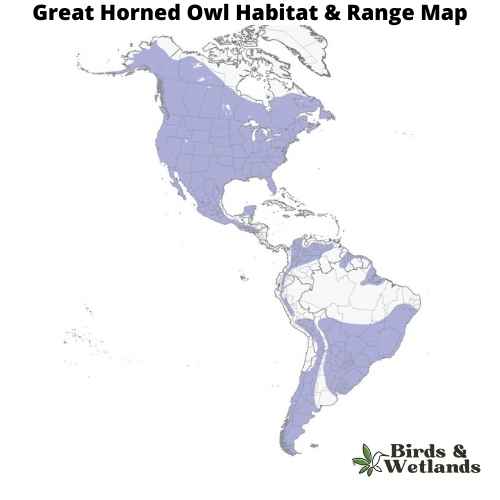
Great Horned Owl Sound
Scientific Name:Bubo virginianus
Length: 18.1-24.8 in
Wingspan: 39.8-57.1 in
Weight: 32.1-88.2 oz
The Great Horned Owl is a large owl with long wings and a large head. It’s one of the most common owls in North America.
Great Horned Owls are large, stocky birds with soft feathers that are gray to brown on their backs and white on their chests. Their faces are characterized by two black “ear” tufts, which can be raised or flattened depending on the owl’s mood. The eyes are yellow, orange, or red in color.
The habitat of the Great Horned Owl is a variety of different environments such as forests and deserts. They also live near water sources such as lakes, streams and rivers where they can hunt for fish.
The diet of the Great Horned Owl consists primarily of small mammals such as mice and rats; however they will also eat other rodents such as squirrels, rabbits and porcupines. They have been known to eat skunks too.
Western Screech-Owl (Western Screech-Owl)
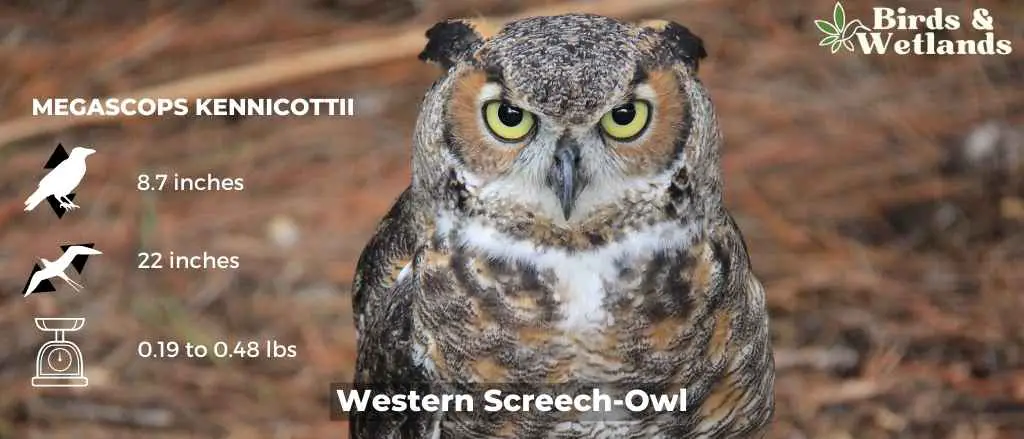
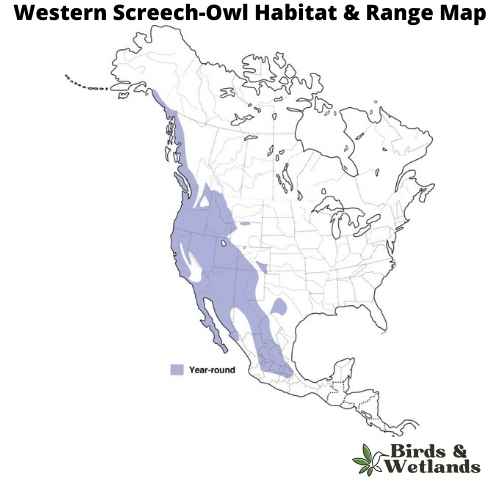
Western Screech-Owl Sound
Scientific Name: Megascops kennicottii
Length: 22 cm (8.7 in)
Wingspan: 55 cm (22 in)n
Weight: 88 to 220 g (3.1 to 7.8 oz)
The Western Screech-Owl, or Megascops kennicottii, is a small species of owl native to North and Central America. Western Screech-Owls are nocturnal predators, and its diet primarily consists of small mammals, birds, insects, and occasionally fish.
This owl is medium-sized compared to other screech-owls. It has a compact, stocky body, and is often recognized by its large head with yellow eyes surrounded by greyish-brown facial disks. The plumage is generally a mixture of grey and brown, with intricate patterns of spots and streaks that provide excellent camouflage against tree bark.
These owls prefer mixed woodland habitats, including deciduous forests and semi-open areas with trees. They often nest in tree cavities, but will also readily take to nest boxes if available. These birds are primarily non-migratory, and once they’ve established a territory, they tend to stay within the same area year-round.
Barred Owl (Strix varia)

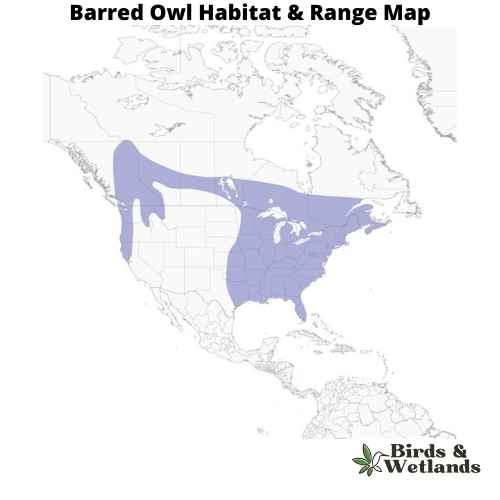
Barred Owl Sound
Scientific Name: Strix varia
Length: 40 to 63 cm (16 to 25 in)
Wingspan: 96 to 125 cm (38 to 49 in)
Weight: 468 to 1,150 g
The Barred Owl is a medium-sized owl with a barred pattern on its chest and belly. They have large yellow eyes that allow them to see well in low light conditions. Their ears are not very large which means they do not hear very well but they have excellent hearing abilities which allow them to detect sounds up to 1 mile away. Their feathers are brown and streaked with white, and they have black bars on their chests and wings.
Their habitats include forests, woodlands, orchards, parks, farmland and suburban backyards.
Barred Owls (also known as hoot owl) eat small mammals such as mice, rats and squirrels. They also eat insects such as beetles or grasshoppers. These owls hunt during the day when it is light out so that they can see their prey better than at night when they would be using senses other than sight like sound or smell to find their food source.
Barred owls are monogamous birds which means they mate for life. They build nests in trees or cavities on the ground and lay 2-4 eggs per year. The incubation period for these eggs lasts about 28 days before hatching takes place.
Barn Owl (Tyto alba)

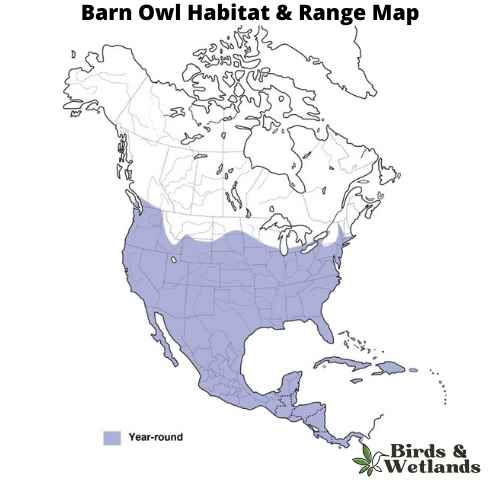
Barn Owl Sound
Scientific Name: Tyto alba
Length: 13 to 15 in
Wingspan: 31 to 37 in
Weight: 9.2 oz
The Barn Owl is a widespread species of owl known for its distinctive heart-shaped facial disc.
Barn Owls are medium-sized owls, they are pale overall with golden-brown wings and back, contrasted by a white face, chest, and belly. Their most notable feature is their heart-shaped facial disc, which helps channel sound to their ears.
Barn Owls are typically found in open habitats, including farmland, woodland, and marshes. They are named for their habit of nesting in human structures such as barns, church towers, and in the hollows of large trees. These owls are nocturnal, hunting at night and roosting during the day.
The diet of Barn Owls primarily consists of small mammals, particularly rodents such as mice and rats. They are known for their silent flight, which allows them to sneak up on their prey without detection.
Barn Owls have a unique nesting behavior. They do not build nests, but instead, lay their eggs directly on the bare surface of a secluded ledge or cavity. A female typically lays 4-7 eggs, and both parents help incubate the eggs and care for the chicks.
The long-eared owl (Asio otus)

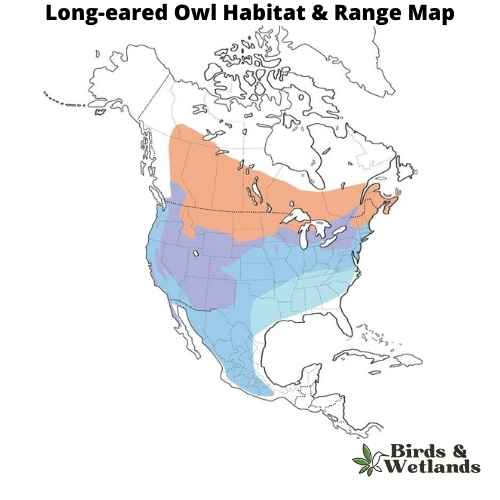
Long-eared Owl Sound
Scientific Name: Asio otus
Length: 12 and 16 in
Wingspan: 2 ft 10 in to 3 ft 4 in
Weight: 5.6 to 15.3 oz
The Long-eared Owl is a medium-sized owl species known for its distinctively long ear tufts, which can be raised or lowered depending on the bird’s mood or intention.
Long-eared Owls have mottled brown and cream plumage, which provides excellent camouflage among the trees. Their most distinctive features are their long, black-tipped ear tufts, which are set closer to the center of the head than in most other owl species.
These owls inhabit a wide variety of habitats, including deciduous and coniferous forests, woodlands, and even semi-deserts.
The Long-eared Owl’s diet primarily consists of small mammals, especially voles, but they will also take small birds and insects. They are skillful hunters, often capturing prey from a perch or in flight.
In terms of nesting behavior, Long-eared Owls do not construct their own nests, instead they take over old nests built by other bird species, usually those of corvids or other large birds. They lay an average of 4 to 5 eggs, which are incubated by the female while the male provides food.
Short-eared Owl (Asio flammeus)


Short-eared Owl Sound
Scientific Name: Asio flammeus
Length: 13–17 in
Wingspan: 33 to 43 in
Weight: 7.3–16.8 oz
The Short-eared Owl is a medium-sized owl species with a wide distribution, found across North and South America, Europe, Asia, and many Pacific islands. Despite its name, the “ears” of the Short-eared Owl are not often visible, as they are small and tend to blend with the bird’s feathers.
The owls are predominantly brown with buff and white accents throughout their body and wings, and dark patches around their yellow eyes.
Short-eared Owls diet consists largely of small mammals, especially voles. However, they are opportunistic hunters and will also prey on a variety of other animals, including other birds, when available.
Their habitat is characterized by open areas like grasslands, marshes, and tundra. They nest on the ground, which is unusual for owls, and this makes them vulnerable to ground predators. As such, they often live in areas with tall grasses or other ground cover for protection.
Northern Saw-whet Owl (Aegolius acadicus)

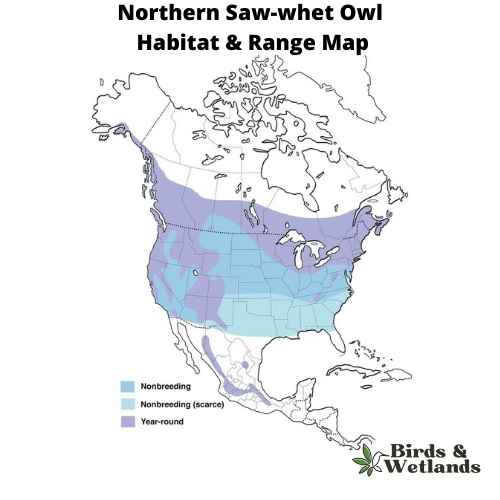
Northern Saw-whet Owl Sound
Scientific Name: Aegolius acadicus
Length: 17–22 cm (6.7–8.7 in)
Wingspan: 42–56.3 cm (16.5–22.2 in)
Weight: 54 to 151 g (1.9 to 5.3 oz)
The Northern Saw-whet Owl is a tiny, speckled gray owl and it’s one of the smallest owls in North America. It’s also known as the Little Owl or Wood Owl in some areas.
Northern Saw-whet Owls have dark brown eyes, white eyebrows, and yellow beak. It has brownish-grey feathers that are spotted with white. The owl’s legs are covered in feathers and appear nearly invisible when the bird is perched on a branch or tree.
In the winter they migrate south to warmer climates. They prefer to live in dense coniferous forest with large trees but will occasionally nest in shrubs or other vegetation that can protect them from predators.
The Northern Saw-whet Owl eats mice and voles (small rodents), small birds, frogs, salamanders, moles and shrews, but unlike most owls they chop their prey up and spread over a few meals. They will also eat insects like beetles and grasshoppers if they are available. It hunts from a perch at night using its excellent hearing to locate prey items within about 30 feet (9 meters) of its nest.
These owls nest in tree cavities usually located close to water sources such as lakes or rivers where they can find their food source (insects). They lay 2-4 eggs at one time which incubate for about 30 days before hatching.
Snowy owl (Bubo scandiacus)
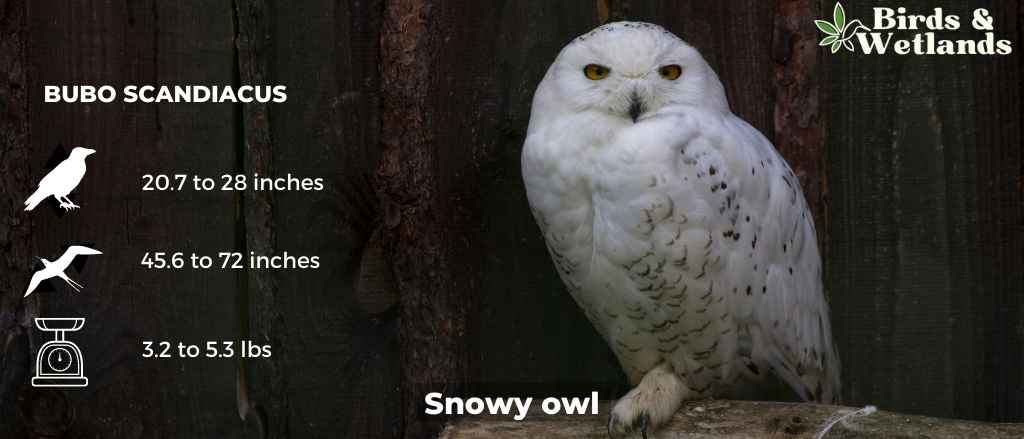
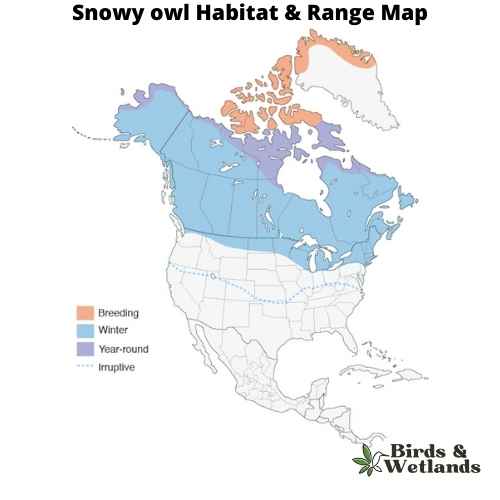
Snowy owl Sound
Scientific Name: Bubo scandiacus
Length: 20.7 to 28 in
Wingspan: 3 ft 10 in to 6 ft 0 in
Weight: 3.2lb to 5.3lb
The Snowy Owl, is of the most well-known species of owls, the Snowy Owl is renowned for its striking appearance and adaptations to its extreme environment.
Snowy Owls are medium sized birds that possess a rounded head, yellow eyes, and a black beak. The most distinctive feature of the Snowy Owl is its white plumage, which provides effective camouflage in its snowy habitat. Male Snowy Owls are often almost completely white, while females and younger owls have more extensive dark barring on their plumage.
Unlike many owl species, Snowy Owls are primarily diurnal, which means they are active during the day. This is an adaptation to life in the Arctic, where there can be 24 hours of daylight in the summer. Their diet mainly consists of small mammals, particularly lemmings, but they are known to eat a variety of animals including birds, fish, and even carrion when necessary.
Snowy Owls nest on the ground, usually on a mound or boulder. Their breeding success is closely tied to the availability of food, and in good years a single pair of owls can raise a large brood of chicks.
Burrowing Owl (Athene cunicularia)

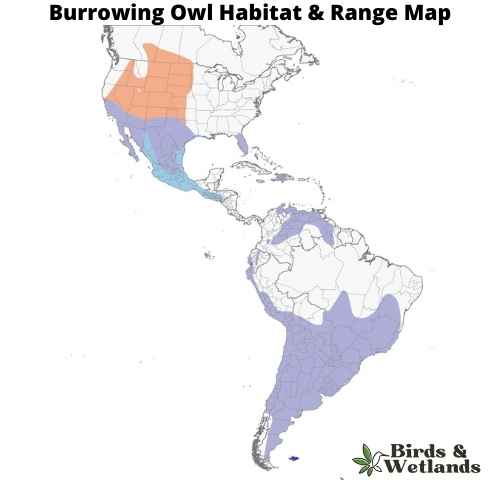
Burrowing Owl Sound
Scientific Name: Athene cunicularia
Length: 7–11 in
Wingspan: 20–24 in
Weight:5–8 oz
The Burrowing Owl is a small, long-legged species of owl found in North and South America. Known for its unusual habit of living in burrows in the ground.
Burrowing Owls have a rounded head with no ear tufts and bright yellow eyes. Their overall coloration is mottled brown and white with a distinct white “eyebrow” above each eye.
Their primary habitat includes open landscapes such as grasslands, deserts, agricultural areas, golf courses, and even airports. As their name suggests, these owls often reside in burrows, many of which are abandoned by prairie dogs, ground squirrels, or other burrowing animals. In some cases, they may also dig their own burrows.
Burrowing Owls diet consists mainly of small mammals and insects, but they also eat birds and reptiles.
Burrowing Owls have a unique nesting behavior. They lay their eggs in an underground burrow to protect them from predators and extreme weather. Clutch sizes range from 6 to 11 eggs, which are incubated for about a month before hatching.
Great Gray Owl (Strix nebulosa)
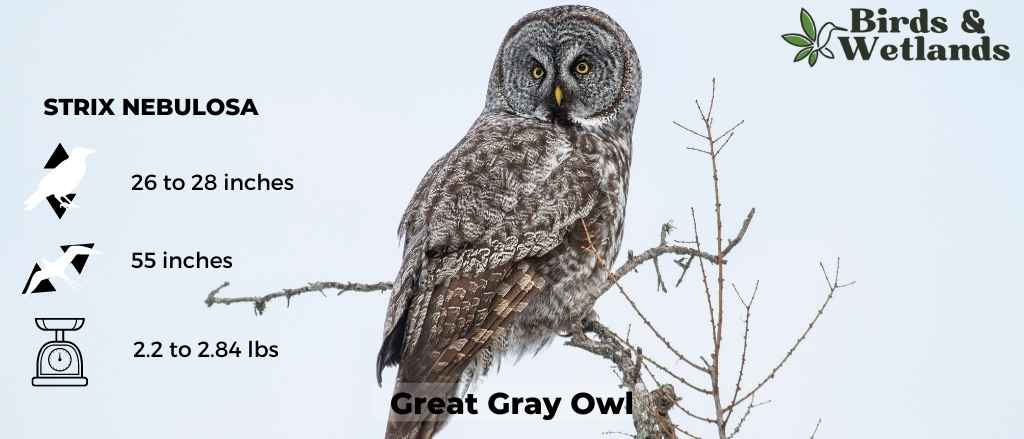
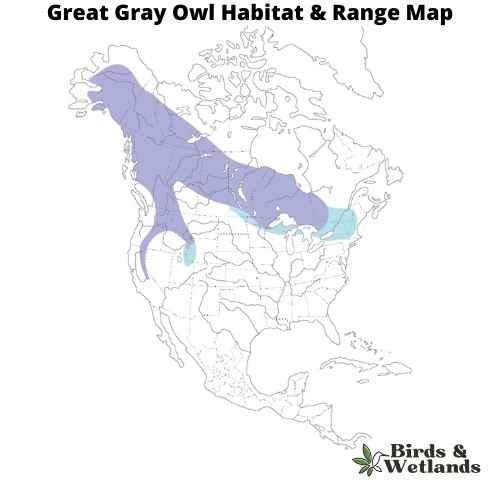
Great Gray Owl Sound
Scientific Name: Strix nebulosa
Length: 26 in to 28 in
Wingspan: 56 to 60 in
Weight:2.2 lb to 2.85lb
The Great Gray Owl, or Strix nebulosa, is a very large owl, native to the boreal forests across North America and Eurasia. Despite its great size, it’s more so known for its impressive appearance rather than its weight, as it is outweighed by several other large owl species.
The Great Gray Owl has a large, rounded head with a grey face and yellow eyes, surrounded by concentric circles of dark and light feathering. It is known for its bow-tie-shaped white moustache stripe and black chin spot.
One of the distinguishing characteristics of this owl is its elongated tail, which makes it appear much larger than it actually is. The plumage is mostly grey with a unique pattern of fine white, gray, and brown streaks and bars. Despite its large size, its diet primarily consists of small rodents, like voles and pocket gophers.
Great Gray Owls prefer dense coniferous forests, often near open meadows or bogs. Rather than building their own nests, they typically use nests previously built by other large birds, such as hawks or crows. They also occasionally nest in broken-top trees or on man-made structures.
Where to Spot Nevada’s Owls
Great Basin National Park, Baker: This park’s varied habitats are home to Great Horned Owls, Western Screech Owls, and Flammulated Owls.
Ash Meadows National Wildlife Refuge, Amargosa Valley: This desert refuge hosts a variety of bird species, including Burrowing Owls and Great Horned Owls.
Desert National Wildlife Refuge, near Las Vegas: The largest national wildlife refuge in the lower 48 states, this area is home to Great Horned Owls, Barn Owls, and Burrowing Owls.
Humboldt-Toiyabe National Forest, Sparks: This expansive forested area is a haven for owls. You may spot Great Horned Owls, Northern Pygmy Owls, and Western Screech Owls.
Red Rock Canyon National Conservation Area, Las Vegas: This conservation area provides habitats for several owl species, including Great Horned Owls and Western Screech Owls.
Remember, when birdwatching, respect for the animals and their habitats is paramount. Maintain a safe distance, keep quiet, and avoid any disruption to the birds or their environments.
| State | Main Owl Watching Sites |
|---|---|
| Oregon Owls | Crater Lake National Park, Malheur National Wildlife Refuge |
| Idaho Owls | Sawtooth National Recreation Area, Craters of the Moon National Monument |
| Utah Owls | Bryce Canyon National Park, Bear River Migratory Bird Refuge |
| Arizona Owls | Grand Canyon National Park, Coconino National Forest |
| California Owls | Yosemite National Park, Point Reyes National Seashore |
Tips on How to Spot Owls in Nevada?
Locations: Some of the best areas to spot owls in Nevada include the Great Basin National Park, Red Rock Canyon National Conservation Area, and the Wetlands Park in Las Vegas. These areas offer a variety of habitats suitable for different owl species.
Timing: Owls are generally most active during dawn and dusk. You might also want to plan your bird watching expeditions to coincide with the breeding season (usually spring) when owls are more vocal and therefore easier to locate.
Listen for Calls: Learning the distinctive calls of different owl species can help you locate these birds, even when they’re hidden. Owls are more likely to call during mating season, which makes it an optimal time to spot them.
Spotting Signs: Look for signs of owl activity, like pellets or white droppings at the base of trees, or feathers stuck to tree branches. These can often indicate a nesting or roosting site nearby.
Patience and Stealth: As owls are often wary of humans, ensure you approach potential owl habitats quietly and with patience. Remember that it might take a while before you spot one.
Equipment: Bring a good pair of binoculars for spotting, and consider a red-filtered flashlight for nighttime viewing, as it can help illuminate owls without disturbing them.
Local Birdwatching Groups: Joining a local birdwatching group can be beneficial. Experienced birdwatchers can provide you with valuable insights and might know about recent owl sightings.

